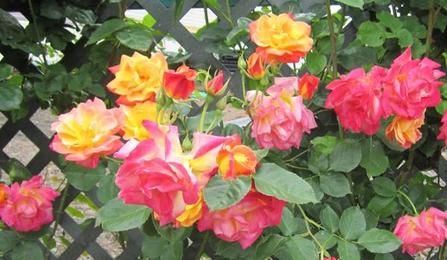by Amanda Moon
Roses can be a beautiful, easily-grown addition to any yard that has
lots of sun and room for them to grow. (To thrive they need a mini-
mum of 6-8 hours sunshine.)
But within the rose family there are different groups and classes, and
if you understand these, you’ll have a better understanding of which
roses will work best in your yard, and which ones will give you the s
hape, color or fragrance that you’re looking for.
Roses are divided into three main groups: antiques, old garden, and
modern. The groups are then divided into classes. These give us an
idea of how a rose will grow, bloom and thrive in a particular area.
Some classes, for example, do best with a heavy pruning every year,
and others are better left alone.
______________________________________________________
Antique Roses: This class contains roses that were introduced before
1867, when the first hybrid tea rose, La France, was introduced. In
some cases many of these roses have been grown somewhere on this
planet for more than 1000 years. So you could say those still in prod-
uction are the ultimate tried and true.
Tea roses are the predecessors of our modern hybrid teas. They typic-
ally have larger blooms full of petals with a high center common with
florist roses. The buds are smaller than hybrid teas and the stems
shorter, but most tea roses have a wonderful light fragrance. The bushes
tend to be large and round and they bloom heavily in the spring and fall.
China roses are one of my favorite rose classes. They are sturdy and
can bloom nine months out of the year. Generally large shrubs (with
some climbers) they are hardy and drought resistant. This is one of
the classes found on abandoned homesteads throughout the state.
The best thing about bourbon roses is their amazing, heady fragrance.
Bourbons can be large shrubs, climbers or smaller more manageable
bushes.
Polyantha roses are smaller bushes, with smaller flowers borne in
clusters at the end of the branches. They bloom profusely and are
very easy to take care of.
______________________________________________________
Old Garden Roses: Though not technically antiques, these roses
have been around long enough to have proven their mettle in our tough
climate.
Hybrid Musk roses really hit their stride starting in the 1920s. They
are large shrubs that can also be trained as small climbers and can take
five hours of sun a day and still bloom well. They have a nice musky
fragrance and bloom in clusters. My family has several musk roses
that have been passed down for more than 60 years.
Older Hybrid Teas have been around so long that they’re now grouped
in with the other antiques and old fashioned roses. They tend to have
longer stems and higher centers than the tea roses. Some of their
blooms, like Peace, can be quite large and showy. They also have more
of an upright, slender growth habit than their predecessors.
______________________________________________________
Modern Roses: This is the ‘everything else’ group. These roses are
more recently developed than the previous group, but still contain
some great rose varieties. It is with the modern roses that we start to
see the huge full flowers that florists crave and the vibrant colors not
seen in antique and older roses. Oranges and bright yellows especially
make their mark with the newer introductions.
Shrub roses were never meant to be classified. They were developed
to grow and behave like blooming shrubs. Knock Out roses are probably
the best examples of this class. They are for the most part disease resist-
ant, fast growing and heavy blooming.
Hybrid Teas and Grandifloras are two classes of roses developed for
their flowers. They have large, full, bright flowers on long stems . . .
perfect for floral arranging. They can require a little more care than
other classes and need yearly hard pruning, but they can’t be beat for
their blooms.
Floribunda roses are best thought of as the original shrub roses. These
are smaller bushes (under 4’ typically) with lots of blooms. They usually
perform very well with little oversight and don’t need much pruning
except to keep their shape.
Here are some of the beautiful roses that we are carrying this year
at the nursery: Climbing Don Juan, Chrysler Imperial, Double Delight,
Christian Dior, Iceberg, Piñata and Josephs coat (both multi-colors),
Fragrant Cloud, Climbing Blaze, a variety of Knockouts, Red Cascade,
Martha Gonzalez and Belinda's Dream. [2 gal: $19.99. 3 gal $29.99]
Last but not least an amazing tale of survival known as Peggy Martin.
This rose was discovered after Katrina had ravaged its homesite,
where she had sat for weeks under brackish water only to come out
alive on the other side. This thorn-less, climbing rose has gained
traction over the last 8 seasons because of this resilience and is a fine
addition to any landscape. Happy rose gardening everyone!


